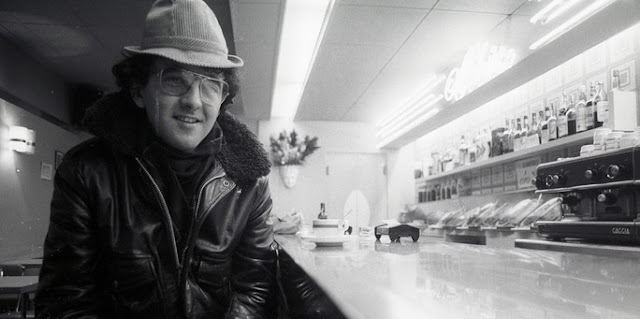Memburu Mitos Bolaño
 |
| Bolaño di Girona, 1984 |
Saya terbaca di Los Angeles Review of Books tentang lawatan seorang penulis ke exhibition Roberto Bolaño:
"As if in reaction to the temptation to lose oneself in these unreal
materials, reminders of reality hang above each glass case: illuminated
photographs of Bolaño, like stills from a forgotten film. Many of the
pictures were taken in photo-booth kiosks, vertical rows of
identification pictures that the author repurposed to fit a given mood.
The man as we know him from the backs of his books is middle-aged,
unflinching, a little sad. Here is boy Bolaño, impossibly young, with
flowing black curls and double bridge glasses. He sits at a restaurant
and in a park, on a city street, with other boys, with girls. In the
background are palm trees, cityscapes, flowers, someone’s apartment. He
broods, glares, and smokes; he smiles, looks away. In a particularly
indelible set of images in the third room, he embraces López and infant
Lautaro, three faces crowding the frame with bittersweet smiles. The
visitor can dream the items in the glass cases — Bolaño’s collection of
science fiction paperbacks, his carefully organized notebooks, the
articles he clipped from newspapers — but then, looking up, must float
back down. Roberto Bolaño is an idea, but he was a man, a person who
smoked on balconies and took his children to the Louvre, as shown in a
photograph from the year before his death."
Sastera mencipta mitos daripada usia dan kematian seorang penulis. Ia adalah sumpahan dan anugerah. Kita tidak pernah mengenali dirinya, seperti mana dia tidak pernah sempat mengenali diri kita. Saya suka menatap potret seorang penulis yang telah mati. Ia berbicara dengan lebih jelas berbanding dengan ucapan seseorang yang masih hidup. Kenapa ya? Saya fikir, kematian memberi suara yang lebih lantang; tetapi ia adalah gema daripada tubuh yang telah mereput menjadi suatu idea yang abadi.


Comments